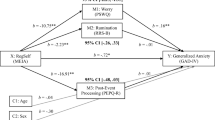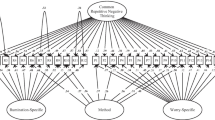Abstract
Theoretical models propose that transdiagnostic and disorder-specific repetitive thinking processes each interact with individual environmental conditions to predict symptoms. The current study aimed to test this hypothesis in the context of social anxiety. Specifically, we aimed to predict future maladaptive social-evaluative beliefs (high standard, conditional, and unconditional beliefs) from: (a) the transdiagnostic tendency to engage in repetitive negative thinking (RNT), (b) the social anxiety-specific tendency to engage in post-event processing (PEP), and (c) the interaction of these repetitive thinking tendencies with the frequency of recent negative social events and social anxiety levels. An initial undergraduate sample (N = 331) was recruited and 215 participants completed measures of the constructs of interest at two time points within an acceptable timeframe (average 8.44 days apart). Using hierarchical linear modelling, significant interactions were only obtained for conditional and unconditional beliefs with a specific component of PEP that focuses on thinking about the past involved in prediction. Follow-up simple slopes analyses indicated mainly no change in these beliefs or decreasing trajectories over time for different combinations of levels on the predictor variables. However, for participants with high social anxiety levels who experienced a high number of recent negative social events, those who reported low levels of thinking about the past exhibited a pattern of increasing trajectories for conditional and unconditional beliefs. These findings indicate that RNT and PEP differ in their ability to predict social-evaluative beliefs, and highlight the importance of research comparing different types of repetitive thinking to better understand these processes.

Similar content being viewed by others
Notes
The RNT was formed by extracting items from measures of specific repetitive thinking processes, including measures of PEP, worry, and rumination (see McEvoy et al., 2010). As such, the RNT construct is represented in part by items that tap PEP. We note that we could have removed PEP items from the RNT-S measure that we used so that the RNT-S and E-PEPQ-15 did not have similar PEP items for conceptual clarity. However, given the way the RNT-S was developed, removal of PEP items from the RNT-S would have compromised the RNT-S measure’s ability to represent the RNT construct. Hence, we use the RNT-S in its original form for this study.
We thank an anonymous reviewer for highlighting this issue.
We note that Time 2 responses submitted greater than 12 days after Time 1 were considered to be beyond an acceptable timeframe and such data were removed for the main analyses (see Participants section). However, before removal of these data for the main analyses, a comparison of the 215 participants who submitted their Time 2 responses within an acceptable timeframe and the 21 participants who submitted their Time 2 responses beyond an acceptable timeframe in terms of their high standard beliefs, conditional beliefs, and unconditional beliefs at Time 2 indicated no differences (all ps > 0.107).
References
Abbott, M. J., & Rapee, R. M. (2004). Post-event rumination and negative self-appraisal in social phobia before and after treatment. Journal of Abnormal Psychology, 113, 136–144. doi:10.1037/0021-843X.113.1.136.
Allen, J. L., & Rapee, R. M. (2009). Are reported differences in life events for anxious children and controls due to comorbid disorders? Journal of Anxiety Disorders, 23, 511–518. doi:10.1016/j.janxdis.2008.10.005.
Beard, C. (2011). Cognitive bias modification for anxiety: current evidence and future directions. Expert Review of Neurotherapeutics, 11, 299–311. doi:10.1586/ern.10.194.
Brown, E. J., Juster, H. R., Heimberg, R. G., & Winning, C. D. (1998). Stressful life events and personality styles: relation to impairment and treatment outcome in patients with social phobia. Journal of Anxiety Disorders, 12, 233–251. doi:10.1016/S0887-6185(98)00012-7.
Clark, D. M., Ehlers, A., McManus, F., Hackman, A., Fennell, M., Campbell, H.,... Louis, B. (2003). Cognitive therapy versus fluoxetine in generalized social phobia: a randomized placebo-controlled trial. Journal of Consulting and Clinical Psychology, 71, 1058–1067. doi: 10.1037/0022-006X.71.6.1058
Clark, D. M., & Wells, A. (1995). A cognitive model of social phobia. In R. G. Heimberg, M. R. Liebowitz, D. A. Hope, & F. R. Schneier (Eds.), Social phobia: Diagnosis, assessment, and treatment (pp. 69–93). New York: The Guilford Press.
Collins, L. M., & Graham, J. W. (2002). The effect of the timing and spacing of observations in longitudinal studies of tobacco and other drug use: temporal design considerations. Drug and Alcohol Dependence, 68, S85–S96. doi:10.1016/S0376-8716(02)00217-X.
Curran, P. J., Bauer, D. J., & Willoughby, M. T. (2004). Testing main effects and interactions in latent curve analysis. Psychological Methods, 9, 220–237. doi:10.1037/1082-989X.9.2.220.
Csikszentmihalyi, M., & Larson, R. W. (1987). Validity and reliability of the experience sampling method. Journal of Nervous and Mental Disease, 175, 526–536.
Edwards, L. J. (2000). Modern statistical techniques for the analysis of longitudinal data in biomedical research. Pediatric Pulmonology, 30, 330–344. doi:10.1002/1099-0496(200010)30:4<330::AID-PPUL10>3.0.CO;2-D.
Ehring, T., & Watkins, E. R. (2008). Repetitive negative thinking as a transdiagnostic process. International Journal of Cognitive Therapy, 1, 192–205. doi:10.1521/ijct.2008.1.3.192.
Ehring, T., Zetsche, U., Weidacker, K., Wahl, K., Schönfeld, S., & Ehlers, A. (2011). The perseverative thinking questionnaire (PTQ): validation of a content-independent measure of repetitive negative thinking. Journal of Behavior Therapy and Experimental Psychiatry, 42, 225–232. doi:10.1016/j.jbtep.2010.12.003.
Fehm, L., Hoyer, J., Schneider, G., Lindemann, C., & Klussman, U. (2008). Assessing post-event processing after social situations: a measure based on the cognitive model for social phobia. Anxiety, Stress, and Coping, 21, 129–142. doi:10.1080/10615800701424672.
Field, A. P., & Morgan, J. (2004). Post-event processing and the retrieval of autobiographical memories in socially anxious individuals. Journal of Anxiety Disorders, 18, 647–663. doi:10.1016/j.janxdis.2003.08.004.
Furmark, T., Tillfors, M., Everz, P. O., Marteinsdottir, I., Gefvert, O., & Fredrikson, M. (1999). Social phobia in the general population: prevalence and sociodemographic profile. Social Psychiatry and Psychiatric Epidemiology, 34, 416–424. doi:10.1007/s001270050163.
Harvey, A. G., Watkins, E., Mansell, W., & Shafran, R. (2004). Cognitive behavioural processes across psychological disorders. Oxford:Oxford University Press.
Heimberg, R. G., Brozovich, F. A., & Rapee, R. M. (2010). A cognitive-behavioral model of social anxiety disorder: update and extension. In S. G. Hofmann, & P. M. DiBartolo (Eds.), Social anxiety: Clinical, developmental, and social perspectives (2nd ed., pp. 395–422). New York: Academic Press.
Leys, C., Ley, C., Klein, O., Bernard, P., & Licata, L. (2013). Detecting outliers: do not use standard deviation around the mean, use absolute deviation around the median. Journal of Experimental Social Psychology, 49, 764–766. doi:10.1016/j.jesp.2013.03.013.
Lovibond, S. H., & Lovibond, P. F. (1995). Manual for the depression anxiety and stress scales (2nd ed., ). Sydney:Psychological Foundation.
Lundh, L. G., & Sperling, M. (2002). Social anxiety and the post-event processing of socially distressing events. Cognitive Behaviour Therapy, 31, 129–134. doi:10.1080/165060702320338004.
Mahoney, A. E. J., McEvoy, P. M., & Moulds, M. L. (2012). Psychometric properties of the repetitive thinking questionnaire in a clinical sample. Journal of Anxiety Disorders, 26, 359–367. doi:10.1016/j.janxdis.2011.12.003.
Makkar, S. R., & Grisham, J. R. (2011). The predictors and contents of post-event processing in social anxiety. Cognitive Therapy and Research, 35, 118–133. doi:10.1007/s10608-011-9357-z.
Mattick, R. P., & Clarke, J. C. (1998). Development and validation of measures of social phobia scrutiny fear and social interaction anxiety. Behaviour Research and Therapy, 36, 455–470. doi:10.1016/S0005-7967(97)10031-6.
McEvoy, P. M. (2007). Effectiveness of cognitive behavioural group therapy for social phobia in a community clinic: a benchmarking study. Behaviour Research and Therapy, 45, 3030–3040. doi:10.1016/j.brat.2007.08.002.
McEvoy, P., Mahoney, A., & Moulds, M. L. (2010). Are worry, rumination, and post-event processing one and the same? Development of the repetitive thinking questionnaire. Journal of Anxiety Disorders, 24, 509–519. doi:10.1016/j.janxdis.2010.03.008.
McEvoy, P. M., Mahoney, A., Perini, S. J., & Kingsep, P. (2009). Changes in post-event processing and metacognitions during cognitive behavioural group therapy for social phobia. Journal of Anxiety Disorders, 23, 617–623. doi:10.1016/j.janxdis.2009.01.011.
McEvoy, P., Moulds, M. L., & Mahoney, A. (2013). Mechanisms driving pre- and post-stressor repetitive negative thinking: metacognitions, cognitive avoidance, and thought control. Journal of Behavior Therapy and Experimental Psychiatry, 44, 84–93. doi:10.1016/j.jbtep.2012.07.011.
Mills, A. C., Grant, D. M., Lechner, W. V., & Judah, M. R. (2013). Psychometric properties of the anticipatory social behaviours questionnaire. Journal of Psychopathology and Behavioral Assessment, 35, 346–355. doi:10.1007/s10862-013-9339-4.
Nolen-Hoeksema, S., & Watkins, E. R. (2011). A heuristic for developing transdiagnostic models of psychopathology: explaining multifinality and divergent trajectories. Perspectives on Psychological Science, 6, 589–609. doi:10.1177/1745691611419672.
Rachman, S., Grüter-Andrew, J., & Shafran, R. (2000). Post-event processing in social anxiety. Behaviour Research and Therapy, 38, 611–617. doi:10.1016/S0005-7967(99)00089-3.
Raudenbush, S. W., Bryk, A. S., & Congdon, R. (2013). HLM 7.01: hierarchical linear and nonlinear modeling [computer software]. Lincolnwood, IL:Scientific Software International.
Ruscio, A. M., Brown, T. A., Chiu, W. T., Sareen, J., Stein, M. B., & Kessler, R. C. (2008). Social fears and social phobia in the United States: results from the national comorbidity survey replication. Psychological Medicine, 38, 15–28. doi:10.1017/S0033291707001699.
Salters-Pedneault, K., Tull, M. T., & Roemer, L. (2004). The role of avoidance of emotional material in the anxiety disorders. Applied and Preventive Psychology, 11, 95–114. doi:10.1016/j.appsy.2004.09.001.
Schafer, J. L., & Graham, J. W. (2002). Missing data: our view of the state of the art. Psychological Methods, 7, 147–177. doi:10.1037//1082-989X.7.2.147.
Singer, J. D., & Willett, J. B. (2003). Applied longitudinal data analysis: Modeling change and event occurrence. New York:Oxford University Press.
Watkins, E. (2008). Constructive and unconstructive repetitive thought. Psychological Bulletin, 134, 163–206. doi:10.1037/0033-2909.134.2.163.
Weeks, J. W., Heimberg, R. G., Fresco, D. M., Hart, T. A., & Turk, C. L. (2005). Empirical validation and psychometric evaluation of the brief fear of negative evaluation scale in patients with social anxiety disorder. Psychological Assessment, 17, 179–190. doi:10.1037/1040-3590.17.2.179.
Wong, Q. J. J. (2014). Psychometric evaluation of the English version of the extended post-event processing questionnaire. Anxiety, Stress, and Coping, 28, 215–225. doi:10.1080/10615806.2014.925546.
Wong, Q. J. J., & Moulds, M. L. (2009). Impact of rumination versus distraction on anxiety and maladaptive self-beliefs in socially anxious individuals. Behaviour Research and Therapy, 47, 861–867. doi:10.1016/j.brat.2009.06.014.
Wong, Q. J. J., & Moulds, M. L. (2011). A new measure of the maladaptive self-beliefs in social anxiety: psychometric properties in a non-clinical sample. Journal of Psychopathology and Behavioral Assessment, 33, 273–284. doi:10.1007/s10862-010-9208-3.
Wong, Q. J. J., & Moulds, M. L. (2012a). Does rumination predict the strength of maladaptive self-beliefs characteristic of social anxiety over time? Cognitive Therapy and Research, 36, 94–102. doi:10.1007/s10608-010-9316-0.
Wong, Q. J. J., & Moulds, M. L. (2012b). Processing mode during repetitive thinking in socially anxious individuals: evidence for a maladaptive experiential mode. Journal of Behavior Therapy and Experimental Psychiatry, 43, 1064–1073. doi:10.1016/j.jbtep.2012.05.002.
Wong, Q. J. J., Moulds, M. L., & Rapee, R. M. (2014). Validation of the self-beliefs related to social anxiety (SBSA) scale: a replication and extension. Assessment, 21, 300–311. doi:10.1177/1073191113485120.
Zou, J. B., & Abbott, M. J. (2012). Self-perception and rumination in social anxiety. Behaviour Research and Therapy, 50, 250–257. doi:10.1016/j.brat.2012.01.007.
Acknowledgments
This study was supported by a National Health and Medical Research Council Early Career Fellowship (APP1037618) awarded to Dr. Quincy J. J. Wong.
Conflict of Interest
Quincy J. J. Wong, Peter M. McEvoy, and Ronald M. Rapee declare that they have no conflicts of interest.
Experiment Participants
The experimental protocols of this study were approved by the the Macquarie University Human Research Ethics Committee (Human Sciences and Humanities) and comply with the guidelines of the Australian Government's National Statement on Ethical Conduct in Human Research (2007). All participants of this study provided informed consent.
Author information
Authors and Affiliations
Corresponding author
Rights and permissions
About this article
Cite this article
Wong, Q.J.J., McEvoy, P.M... & Rapee, R.M. A Comparison of Repetitive Negative Thinking and Post-Event Processing in the Prediction of Maladaptive Social-Evaluative Beliefs: A Short-Term Prospective Study. J Psychopathol Behav Assess 38, 230–241 (2016). https://doi.org/10.1007/s10862-015-9506-x
Published:
Issue Date:
DOI: https://doi.org/10.1007/s10862-015-9506-x




